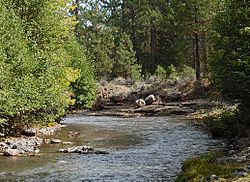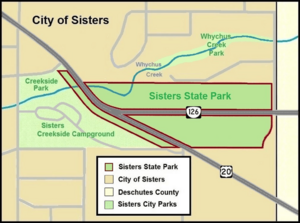Sisters State Park facts for kids
Quick facts for kids Sisters State Park |
|
|---|---|

Whychus Creek in Sisters State Park
|
|
| Lua error in Module:Location_map at line 420: attempt to index field 'wikibase' (a nil value). | |
| Location | Deschutes County, Oregon |
| Nearest city | Sisters, Oregon, US |
| Area | 28 acres (11 ha) |
| Created | 1939 |
| Operated by | Oregon Parks and Recreation Department |
Sisters State Park is a cool state park found on the southeast side of Sisters, a town in Deschutes County, Oregon, USA. This park is special because it's split into three parts by two main roads, U.S. Route 20 and Oregon Route 126. It covers about 28 acres (11 hectares) of beautiful forest right next to Whychus Creek. The park is managed by the Oregon Parks and Recreation Department. It's also right next to two city parks that used to be part of the state park.
Contents
Discovering Sisters State Park's Past
How Sisters State Park Began
Sisters State Park is in an area that was important to Native American tribes long ago. Four different trails used by these tribes met near where the park is today. One trail came from the north, near The Dalles. Another came from the northeast. A third trail came from the Sparks Lake area to the southwest. The fourth trail followed what was later known as the Scott Trail from the west.
The park was officially created in 1939. It got its name from the nearby town of Sisters. The town itself is named after the Three Sisters, which are three huge volcanic mountains. These mountains stand tall and overlook the community.
Protecting the Old-Growth Forest
The land for Sisters State Park was bought by a person named Louis W. Hill. He wanted to make sure the old, tall ponderosa pine trees on the property were saved. He donated the land to the State of Oregon so that future generations could enjoy this special forest. Mr. Hill also wanted to make sure the land wasn't used in a way that would cause traffic problems near the highway.
Sharing the Park with the City
In 1983, the State of Oregon gave about 13 acres (5.3 hectares) of the park land to the City of Sisters. This part of the park is on the west side of U.S. Route 20. The city then used this land to create two new city parks right next to the state park.
One of these city parks is a picnic area called Creekside Park. It's on the north side of Whychus Creek. The other is a camping area called Sisters Creekside Campground, on the south side of the creek. Both of these parks are now managed by the City of Sisters. The state park land that remains is east of these two city parks.
Exploring the Park's Landscape
Where is Sisters State Park Located?
Sisters State Park is located right inside the town of Sisters. This town is in Deschutes County, Oregon in the area known as Central Oregon. The land around the park is mostly for homes. To the west, you'll find the two city parks. A city street borders the east side of the park.
How the Park is Divided
The park is split into three sections by U.S. Route 20 and Oregon Route 126. The place where these two highways meet is right in the middle of the park. One part of the park is a thin strip of land along the west side of Route 20. The other two parts are located north and south of Route 126.
Whychus Creek's Journey Through the Park
Whychus Creek is a stream that flows all year round. It starts in the Three Sisters Wilderness area. The creek flows from the southwest to the northeast right through the park. On the west side, the creek separates the two city parks. It then goes under the highway and through Sisters State Park. The land in the park is mostly flat, with a gentle slope down towards Whychus Creek.
Discovering the Park's Plants and Animals
Plants and Trees in Sisters State Park
Whychus Creek creates a narrow green area called a riparian zone through the middle of the park. However, most of the park is an open conifer forest. The soil in the park is loose and sandy. This soil helps a large group of old ponderosa pine trees grow tall. You can also find Quaking aspen trees in the park.
Common plants that cover the ground include Manzanita and wax currant. In the spring, you might see beautiful wildflowers like arrow balsam, Indian paintbrush, lupine, penstemon, and pinedrop.
Fish and Wildlife in Whychus Creek
The amount of water in Whychus Creek changes a lot with the seasons. It's high in the spring when snow melts, and much lower in late summer. Even so, the creek is home to native fish. You might find small rainbow trout upstream from the campground. Larger fish, like redband trout up to 18 inches (46 cm) long, can be found downstream. These larger fish live closer to where the creek flows into the Deschutes River.
Mammals and Birds of the Park
Many different animals live in the Whychus Creek area. Large mammals include black-tail deer, mule deer, coyotes, American black bears, and bobcats. Smaller mammals you might spot are American badgers, common porcupines, striped skunks, raccoons, black-tailed jackrabbits, western gray squirrels, golden-mantled ground squirrels, and least chipmunks.
Many types of birds also live in the Sisters area. You can often see Mountain chickadees, Western meadowlarks, mountain bluebirds, Brewer's blackbirds, and several kinds of warblers. Other bigger birds include northern flickers, black-billed magpies, American kestrels, Cooper's hawks, and red-tailed hawks. There are also 11 different types of woodpeckers!
Nearby City Parks
While Sisters State Park is mostly undeveloped forest, the city parks next to it are set up for people to use. These two city parks cover about 13 acres (5.3 hectares) and are very popular. They have good roads and parking areas.
Creekside Park has a large, well-kept lawn. It also has a drinking fountain, benches, picnic tables, and barbeque grills for day use. The camping area, Sisters Creekside Campground, has grassy spots with water taps, restrooms, and showers. The campground has 60 campsites, and 25 of them have hook-ups for recreational vehicles. Each campsite has picnic tables and fire pits.
Whychus Creek divides the two city parks. However, there's a covered walking bridge that connects them, so you can easily go between both. Both parks are also close enough to walk to downtown Sisters.
Images for kids







